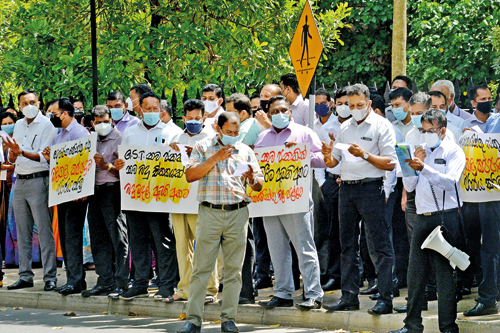From thousands to millions
View(s):
Rising prices have led to many street protests by trade unions.
I was impressed by an old newspaper advertisement that I received a few days ago. The advertisement had been published in order to announce a 10 per cent reduction in sales prices of motorbikes in Sri Lanka, which was then called, Ceylon. Whatever the exact date of the newspaper issue, the advertisement says that it is a “Special Vesak Offer” valid until June 5 1955.
The offer is for “Jawa-CZ motorbikes” imported from Czechoslovakia. Jawa-CZ was one of the oldest motorbike manufacturing companies, founded in Czechoslovakia in 1929. While it became an internationally acclaimed and popular motorbike brand, its “Perak” model also won a gold medal at the Paris Motor Show in 1946 which considerably improved its international demand.
Under the communist rule in Czechoslovakia, the Jawa-CZ company was also nationalised. International demand, particularly from the US and other capitalist countries declined. But the newly-independent underdeveloped countries which had a good rapport with socialist countries continued to provide a lucrative market for the Jawa-CZ motorbikes.
As the international reputation of Jawa-CZ continued to remain high, it had established export markets in over 100 countries in the world, while the majority of them were developing countries. As new competitors emerged from Japan and other Asian countries, the golden era of Jawa-CZ declined since the 1970s. The company entered into license agreements to produce Jawa-CZ models in other countries, including India.
It was also in the 1950s that a couple of Sri Lankans did a Jawa-CZ promotional motorbike ride from Colombo to London through Prague – the capital city in Czechoslovakia. According to my knowledge, they were supported by the Jawa-CZ company, providing them with even motorbikes for the promotional ride. The group had completed the journey, reaching there through a transnational and exhausting motorbike journey across the continents. And then, they settled down in London!
Decades of price change
This old motorbike advertisement which appeared in a local newspaper as far back as 1955 would attract anyone’s attention, because of not the brand name, but the price of motorbikes. For instance, the sale price of a 250cc bike was quoted as Rs. 1,950 and that of a 125cc bike as Rs. 1,550.
If you now compare the local prices of motorbikes with the same engine capacity, they are in the range of half a million to one million rupees; under the prevailing import restrictions and high import duties, these prices can rise even further!
 Many of the people from older generations remember that prices of goods and services were amazingly lower those days, compared to what the present generations are faced with. What factors have caused such prices to rise from thousands to millions within 65 years? Is it a normal price trend that has happened all around the world or a problem of only some of the countries?
Many of the people from older generations remember that prices of goods and services were amazingly lower those days, compared to what the present generations are faced with. What factors have caused such prices to rise from thousands to millions within 65 years? Is it a normal price trend that has happened all around the world or a problem of only some of the countries?
I am going to find simple answers to these questions from a historical point of view, avoiding their underlying complex analyses. The first thing that we need to understand is that always the prices should be viewed in relation to income.
Prices may be lower, but it’s not a reason to argue that we can afford it because our incomes are also lower. The inverse is true as well. Prices may be higher, but it doesn’t matter because people’s income too are higher. What matters ultimately is whether income growth has been faster than the increase in prices!
The main problem that we are faced today in Sri Lanka is that the prices have doubled, trebled or quadrupled within a short period of little more than 12 months, whereas incomes have hardly changed. As a result, Sri Lanka as a nation has become poorer today than what it was in 2021. This is anyway, a very specific short-term issue related to the present economic crisis, whereas our question is more about long-term changes in local prices of some specific commodities like motorbikes.
Long-term price changes
Globally, there have been both upward and downward price trends embodied in the historical economic transformation. Technological progress causing productivity growth in manufacturing and the shift in production process towards low-cost locations both entailed downward pressure on prices.
In the early 20th Century, the automobile industry in the West was just progressing. A fewer number of automobiles that were produced was only for a smaller and exclusive group of people who could afford them with their higher incomes. As industrialisation expanded and productivity improved, these commodities were gradually accessible to a growing segment of the population.
Similarly, information and communication as well as travelling and transport were expensive about 40 years ago. But due to technological progress and mass production, these services have become remarkably cheaper today.
Secondly, the location of production facilities shifted from the West to low-cost Asia since the mid-20th Century so that manufactured goods became cheaper. Although the manufacturing of motorbikes was limited to the US and a few European countries in the early 20th Century, since the second half of the Century these manufacturing facilities shifted to Japan and other East Asian countries, as well as to India in South Asia.
The most important factor that can cause long-term upward price changes is the global inflation, which increased in the 1960s and the 1970s. Since then, however, global inflation remained subdued over the long-term. Besides, on average global incomes increased over and above global inflationary trends.
Exchange rate matters
While the global community without any exception benefited from the downward pressure on prices due to the above reasons, some of the developing countries including Sri Lanka had to face upward pressure due to their exchange rate problem.
The exchange rate of the Sri Lankan rupee was officially determined at that time against the British pound (GBP), as Rs. 13.33 per GBP. Accordingly, the cross rate between Sri Lankan rupees and the US dollar (USD) which was around Rs. 4.75 per USD, was determined by the exchange rate between GBP and the USD.
The world had the fixed exchange rate system as decided at the Bretton Woods conference in 1944 so that the Rupee – GBP exchange rate remained fixed until it was abolished in 1977. Therefore, the local price of any imported commodity was determined by Sri Lanka’s fixed exchange rate against the GBP. Accordingly, if the international price of a motorbike was GBP 150, its local price continued to remain at nearly Rs. 2000.
A non-economic question is why we changed such a good exchange rate system. Well, the answer is that maintaining a fixed exchange rate requires Central Bank’s obligation to supply foreign exchange in order to meet excess demand for international currency. The Central Bank cannot print dollars or pounds or any other foreign currency, which has to be earned by producing exports.
As Sri Lanka has to pay a fewer number of rupees per USD each day as the Central Bank doesn’t have enough foreign exchange to fill the gaps every day, the fixed exchange rate system had an end; it was ended on November 15 1977 so that overnight the rupee-dollar exchange rate depreciated from Rs. 8.60 to Rs. 16 per USD. And, immediately all local prices of imports almost doubled.
Real tragedy
Over the past 45 years since then, the rupee – dollar exchange rate depreciated non-stop from Rs. 16 to Rs. 365, which is quite an unusual trend for an emerging market economy. The reason is that Sri Lanka failed to generate enough foreign exchange inflows. Consequently, anything we import continued to be more expensive day-by-day.
Although the post-1977 economic policy regime was known as “export-oriented”, its export-orientation continued to suffer from both the negative repercussions of the war on the one hand, and the policy reversals and large-scale corruptions on the other hand.
All the countries which had placed their exchange rate movements on export growth, continued to maintain exchange rate stability. Countries, where the exchange rate was influenced more by short-term capital flows than by export growth, had the problem of exchange rate volatility and demanded Central Bank’s interference to manage it. The only way that Sri Lanka can reverse the tragedy is to shift its policies and regulations to prioritise export growth.
(The writer is a Professor of Economics at the University of Colombo and can be reached at sirimal@econ.cmb.ac.lk and follow on Twitter @SirimalAshoka).
Hitad.lk has you covered with quality used or brand new cars for sale that are budget friendly yet reliable! Now is the time to sell your old ride for something more attractive to today's modern automotive market demands. Browse through our selection of affordable options now on Hitad.lk before deciding on what will work best for you!


